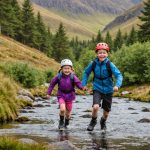Overview of Moorland Navigation Safety
Moorland navigation presents a unique set of challenges that require careful preparation and awareness. The vast and often featureless landscapes of UK moorlands can easily disorient even experienced navigators, emphasising the importance of proper navigation skills and safety practices.
Navigators often face significant challenges, such as unpredictable weather, limited visibility, and the scarcity of distinct landmarks. These factors can lead to navigational errors and increase the risk of becoming lost. Thus, it’s crucial to be well-versed in safe navigation practices to ensure a successful journey.
In the same genre : The comprehensive handbook for camping stove best practices and maintenance essentials in the uk
Effective navigation involves an understanding of both traditional and modern techniques. While digital devices provide convenience, familiarity with map reading and compass skills remains invaluable. Additionally, carrying a physical map ensures you are prepared for any technological failures.
Prior to embarking, assess the terrain and plan routes that account for known hazards and anticipated weather conditions. Preparation enhances safety, confidence, and enjoyment in the moorland environment. It is essential to brief someone on your plans and anticipated return time. Taking these precautions will greatly contribute to a risk-free adventure in the moorlands.
Also to discover : Unveil the best uk campsites for enchanting stargazing escapades in dark sky parks
Essential Camping Gear for Moorlands
When planning a moorland camping trip, having the right camping gear is crucial for both safety and comfort. Given the unpredictable nature of UK moorlands, your equipment must be carefully selected to withstand variable conditions.
The key to a successful moorland adventure starts with a well-thought-out packing list. Moorland camping essentials include a durable, weather-resistant tent, which provides reliable shelter against wind and rain. Sleeping bags suited for cold temperatures are also crucial, ensuring warmth during chilly nights.
It’s important to consider the quality of outdoor equipment. When selecting gear, look for items designed specifically for rugged terrain and unpredictable weather. For instance, waterproof clothing and sturdy hiking boots are indispensable for navigating wet and uneven paths.
While packing light is advised, ensure you have all necessary items. A lightweight backpack helps manage your load without sacrificing essentials like navigation tools, first aid kits, and cooking supplies. Prioritising versatile gear that can serve multiple purposes can significantly reduce weight.
Remember, the right equipment not only enhances your camping experience but also serves as the foundation for a safe and enjoyable moorland journey.
Navigation Techniques for Moorland Exploration
Understanding effective navigation techniques is paramount for successful moorland exploration. Navigators utilise both traditional and modern tools to traverse these challenging landscapes.
Traditional Navigation Skills
The enduring value of traditional navigation skills such as map reading and compass use cannot be underestimated. Proficiency in reading topographic maps allows explorers to discern terrain features, contour lines, and potential obstacles. The compass, a timeless tool, offers reliable directional guidance and is invaluable when visibility is poor or GPS devices fail. Mastery of these skills ensures one can confidently navigate even without electronic aids.
Modern Navigation Tools
Incorporating modern navigation tools enhances navigational accuracy and convenience. GPS devices and mobile applications offer real-time positioning and interactive maps, allowing for dynamic route adjustments. When venturing into remote moorlands, ensure devices are fully charged and consider carrying portable chargers to prevent technology failure.
Integration of Technology in Navigation
Balancing traditional methods with modern technology provides the best of both worlds. While digital tools offer numerous advantages, reliance can lead to complications if they malfunction. Thus, a hybrid approach ensures comprehensive preparedness. Regular practice of both methods can refine skills and boost one’s confidence in navigating the unpredictable moorland terrains.
Understanding Local Regulations and Environmental Protection
When camping in UK moorlands, staying informed about local regulations is essential. Licensing and regulations vary across regions, so it’s crucial to check specific requirements for the area you plan to visit. In some locations, permits are needed for activities like camping and fishing. Penalties for non-compliance with these laws may involve fines or bans from the area.
Responsible camping practices protect the fragile moorland ecosystem, preserving its natural beauty. Awareness of environmental protection means following guidelines for waste disposal and minimising your environmental footprint. Campers should use designated paths and camping spots whenever possible to avoid disturbing wildlife and trampling vegetation.
Additionally, leaving no trace is fundamental. This includes packing out all rubbish, avoiding disturbance of local flora, and following advice to use biodegradable products. By respecting these practices, you help maintain local flora and fauna and ensure these landscapes remain pristine for future explorers.
Understanding and adhering to these camping laws not only protects the environment but enriches your camping experience, fostering a deeper appreciation for the natural spaces you enjoy.
Personal Safety Practices in Moorland Camping
Personal safety is paramount when venturing into the moorlands, as these wild landscapes can pose significant threats. Ensuring basic first aid knowledge equips campers to handle emergencies like sprains or minor cuts. Carrying a comprehensive first aid kit, complete with bandages, antiseptic wipes, and pain relievers, is essential.
Before setting out, engage in thorough risk management. Assess potential hazards like steep inclines or waterlogged areas and plan accordingly to mitigate them. Familiarisation with weather forecasts and terrain specifics greatly aids in preparing for unexpected events.
An integral part of safety is informing someone about your itinerary. Always notify a friend or family member about your planned route and expected return time. This simple step ensures that help can be directed your way if unforeseen circumstances arise.
Remember, the unpredictable nature of the UK moorlands demands vigilance. Preparation is key to conquering these challenges, allowing you to enjoy the tranquillity and beauty of the moorlands safely. Consider personal safety measures as an ongoing journey, constantly refining your skills and knowledge to adapt to new situations encountered in these adventurous terrains.
Expert Insights and Personal Stories
Immerse yourself in the expert tips gleaned from experienced moorland campers who have mastered these breathtaking landscapes. Their confidences lay foundations for thrilling expeditions while ensuring safety to toe the line.
Interviews with Seasoned Moorland Campers
Personal anecdotes from seasoned explorers enrich our understanding. One expert recounts using traditional navigation techniques during an unexpected fog, highlighting the essence of nimbleness and readiness. Mastery of map reading and compass skills was pivotal.
Case Studies of Successful Moorland Expeditions
Showcasing triumphs, these camping stories serve as powerful templates for achieving enjoyable sojourns. Successful expeditions underscore the significance of careful planning, capable execution, and embracing adaptability.
Lessons Learned from Challenges Faced
Experience becomes tangible through personal experiences and stories detailing encounters with the unforeseen. One particpant mistook a landmark, demonstrating the importance of revisiting planned routes frequently. Such lessons underline the need for vigilance and preparedness in the wild moors. Each story captures the thrill and unpredictability of the journey, ultimately enhancing every adventurer’s arsenal.
These expert insights coupled with personal narratives forge a comprehensive resource, fostering safer and more fulfilling explorations of UK moorlands.
Practical Checklists for Moorland Adventures
When planning a moorland adventure, having a detailed checklist ensures no essential items are left behind. A well-structured camping preparation list includes must-have camping gear such as a durable tent, resistant sleeping bag, and reliable cooking equipment. These essentials provide shelter, warmth, and sustenance, forming the core of any outdoor gear ensemble.
Essential Items for Moorland Navigation
Navigate the sprawling UK moorlands by incorporating navigation preparation tools into your checklist. A physical map, compass, and charged GPS device are crucial for maintaining orientation and adjusting routes. Practicing navigation skills ensures that modern technology failures do not compromise safety.
Safety and Emergency Equipment Checklist
Preparation is key. A comprehensive safety checklist encompasses first aid kits, emergency shelters, and portable chargers to avert mishaps. The inclusion of high-energy snacks and enough water is vital, especially for longer journeys in unpredictable conditions.
By systematically addressing personal and navigational needs, a thorough checklist empowers adventurers with the confidence and readiness necessary for safe and enjoyable moorland camping experiences. Regularly updating the list based on past excursions and anticipated conditions refines its effectiveness, ensuring a smooth and well-organised trip.
Creating a Responsible Itinerary
Crafting a responsible itinerary is pivotal for safe and enjoyable moorland adventures. Tightly woven itinerary planning ensures timely navigation, allowing you to fully appreciate the UK’s sprawling moorlands. A well-considered itinerary considers not just distance, but also the ever-changing weather patterns unique to these landscapes. Estimating travel time is crucial; moorland terrains can be deceptive, with uneven paths stretching a supposedly short journey into a prolonged trek.
When planning navigation routes, account for identifiable landmarks to prevent disorientation amidst the vast expanses. Incorporate ample time margins for unpredictable weather shifts; a sudden fog can obscure paths, elongating travel times. Additionally, factor in potential hazards such as waterlogged areas or steep descents, adjusting your camping schedule to accommodate safe passage and rest periods.
Adapting to environmental changes is key. Regularly check weather updates to refine your itinerary accordingly. Flexibility within your camping schedule aids in navigating unforeseen obstacles with ease and grace. This careful approach not only enhances your adventure but ensures a respectful interaction with the moorland environment, promoting safety and appreciation of these breathtaking vistas.











